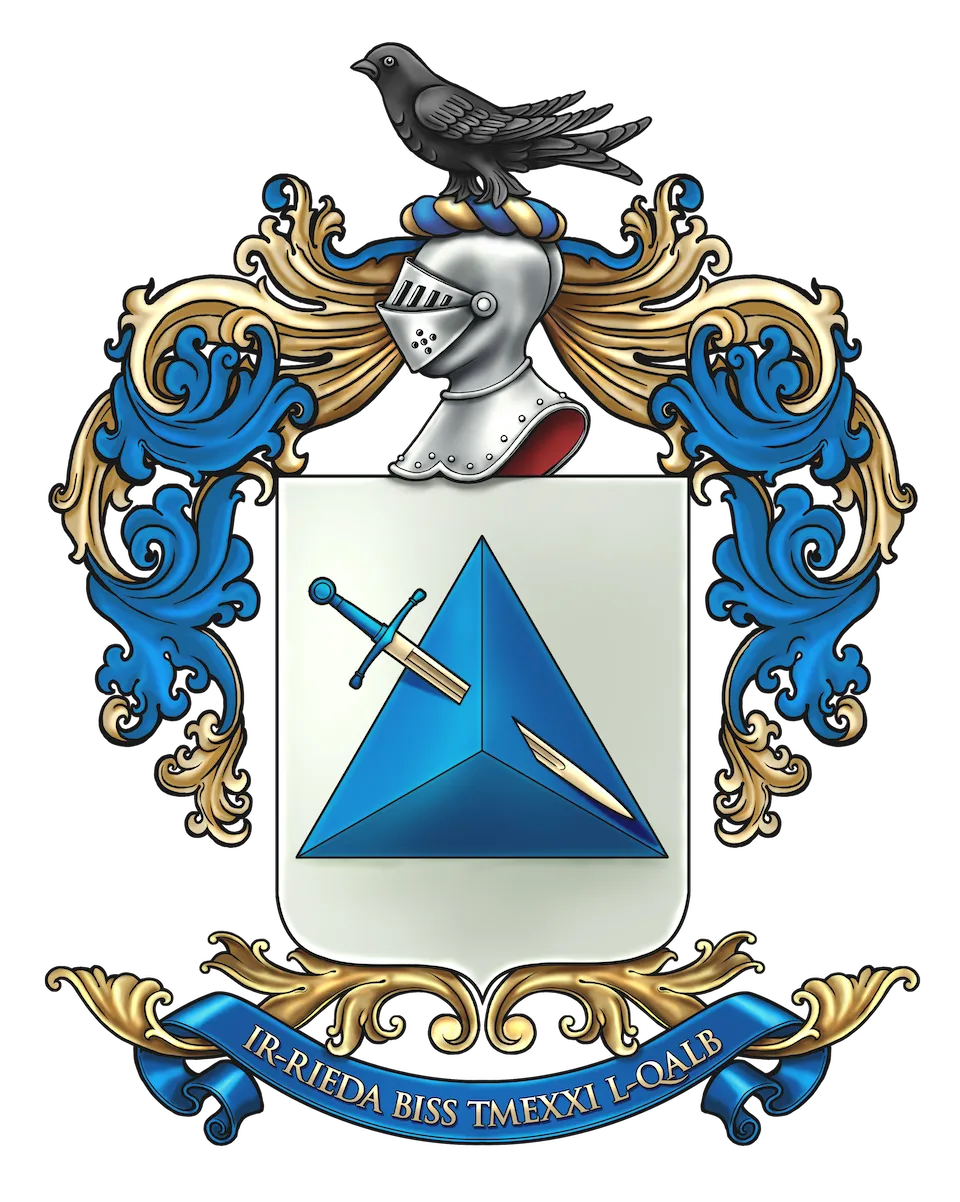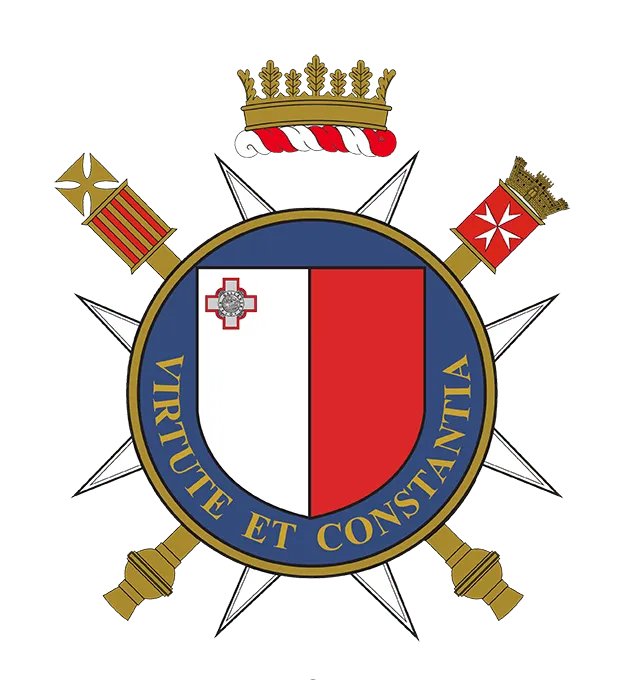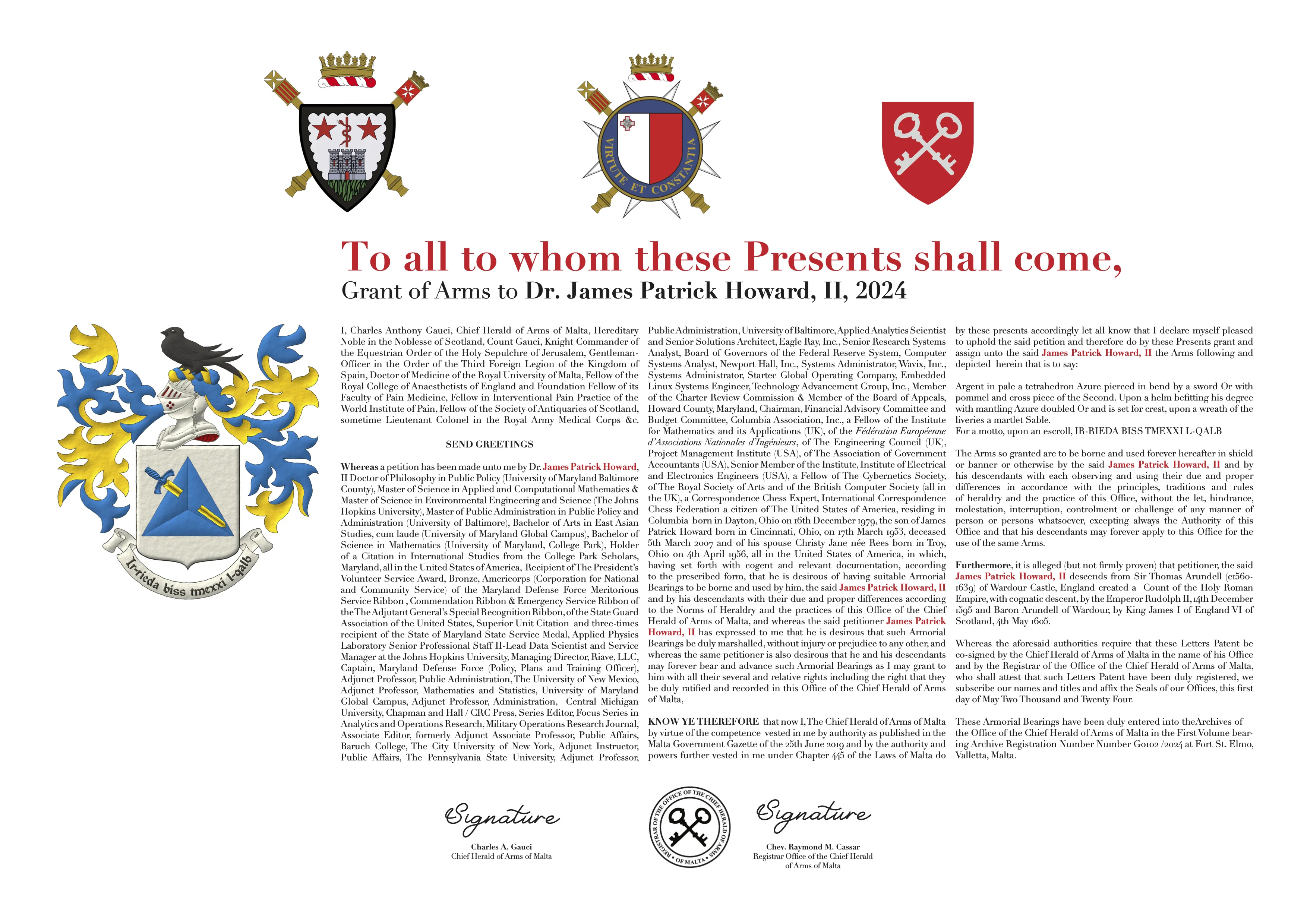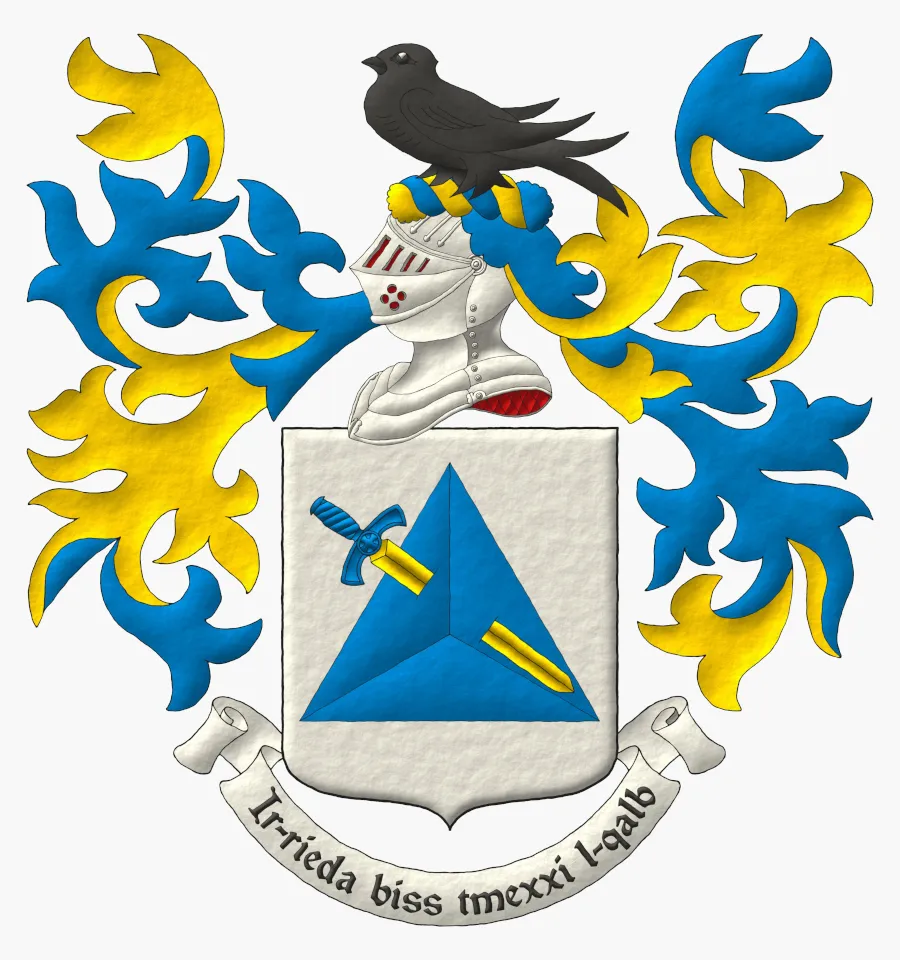Maltese Coat of Arms



At its core, heraldry started as a means of identification, evolving over centuries from simple insignias to the complex art of designing, displaying, and studying coats of arms. As we recognize it, the tradition of heraldry emerged in the early 12th century, primarily serving the practical purpose of distinguishing combatants who were otherwise anonymized by their armor on the battlefield. This necessity gave rise to the role of the herald, individuals who, clad in a distinctive tabard, were tasked with conveying messages and issuing challenges for their sovereigns or lords. They were shielded from harm and armed with extensive knowledge of the armorial symbols within their jurisdiction and beyond.
Over time, heralds gained the sovereign-backed authority to grant coats of arms officially. Although the decline of armor in warfare diminished heraldry’s original functional role, it had already cemented its place within the societal fabric, symbolizing status and identity far beyond the battlefield. Coats of arms expanded in scope and were awarded to the aristocracy and notable figures in society seeking a distinctive form of identification amid widespread illiteracy.
In the modern era, heraldry has transcended its practical origins to become predominantly a symbol of prestige and heritage. While some may attempt to adopt self-styled arms, proper legal recognition of a coat of arms requires sanctioning by an authoritative body acting under a mandate from the state. This ensures that heraldry remains a respected tradition grounded in legitimacy and historical continuity.
The Republic of Malta boasts a rich tapestry of European heraldic tradition, adorned with coats of arms that narrate the island’s history through its noble families, the esteemed Order of St. John, and the ecclesiastical heritage. This heraldic legacy extends to various institutions, including companies, schools, and corporations, each bearing unique armorial symbols that contribute to the cultural mosaic of the Maltese Islands.

For a long time, the vibrant array of heraldic emblems across Malta evolved without the oversight of a central regulatory body. This changed with the recent establishment of the Office of the Chief Herald of Arms of Malta, located within the historic confines of Fort St Elmo in Valletta. Count Charles Gauci’s appointment as the inaugural Chief Herald of Arms in 2019 marked the beginning of a new era in Maltese heraldry.
Under the auspices of the Chief Herald of Arms, all newly granted or registered coats of arms receive official recognition by the State, ensuring their protection from unauthorized replication. The Chief Herald’s office regulates personal and corporate heraldic symbols throughout Malta. This includes the creation and grant of new arms, the registration of long-standing local arms, and the acknowledgment of arms granted by recognized foreign authorities.
I received a grant of arms from the Office of the Chief Herald of Arms of Malta, formalized through Letters Patent numbered G0102, issued on May 1, 2024. The formal notice of this grant was published in the Gazzetta tal-Gvern ta’ Malta, the official gazette of the Government of Malta, in issue number 21,194, on Feburary 16, 2024. This publication serves as the official record, ensuring transparency and public acknowledgment of the newly granted arms.
This coat of arms, now officially recorded and recognized, joins a storied collection of heraldic emblems that reflect the diverse heritage and dynamic future of Malta. It stands as a symbol of honor and distinction, offering a lasting legacy that will be cherished by generations to come.

Or you may download the PDF here.
A blazon is the formal language of heraldry, an intricate system of symbols and descriptions used for centuries to convey the composition of coats of arms. It is a precise and codified language that allows heralds and enthusiasts alike to recreate the visual splendor of a heraldic shield from textual descriptions alone. Each term in a blazon specifies colors, patterns, symbols, and placement, ensuring that the coat of arms can be accurately interpreted and replicated anywhere in the world.
Argent in pale a tetrahedron Azure pierced in bend by a sword Or with pommel and cross piece of the Second. Upon a helm befitting his degree with mantling Azure and doubled Or is set for crest, upon a wreath of the liveries a martlet Sable
The blazon presented encapsulates a deeply personal and symbolic heraldic identity, reflective of both heritage and individual achievement. At its heart, the argent field sets a stage of purity and sincerity, upon which a tetrahedron azure is prominently featured. This geometric figure is not chosen randomly; it is a deliberate nod to the world of mathematics, representing the bearer’s role within this discipline. The tetrahedron, a solid figure with four triangular faces, is foundational in geometric studies and serves as a metaphor for stability and intellectual building blocks, mirroring the bearer’s contributions to and foundations in mathematics.
Piercing the tetrahedron in bend is a sword, or; the seal of Cincinnati, Ohio, directly inspires its design. This choice links the bearer’s heraldic identity to a significant locale. The imagery of the sword also evokes the legendary tale of King Arthur’s Excalibur, suggesting themes of nobility, valor, and the destined right to leadership. The “sword-in-the-stone” allusion enriches the emblem with a narrative of overcoming challenges to achieve one’s rightful place, much like the mythical king.

The crest features a martlet sable, a heraldic charge that holds rich symbolism within the realm of heraldry. Suggested by Count Gauci, the martlet’s inclusion hints at a lineage likely connecting me to Thomas Arundell, whose arms bore six martlets. While the descent remains unproven, the martlet is a significant symbol in heraldry, often representing continuous quest and ambition. Traditionally depicted without feet, the martlet is said to be in perpetual flight, emblematic of constant endeavor and the pursuit of higher aspirations. This imagery aligns with the bearer’s journey of discovery and excellence in their field. Therefore, the use of the martlet is not only a potential nod to ancestral ties but also a testament to the bearer’s tireless dedication and pursuit of knowledge, embodying the spirit of ambition and the relentless pursuit of achievement.
In addition to incorporating the martlet into the crest of the coat of arms, I’ve embraced a unique cross-cultural heraldic approach by creating an image of the martlet styled as a Japanese kamon. A kamon is a form of Japanese heraldry, symbolizing family crests or emblems that date back to the Heian period (794-1185). Traditionally used to identify family lineage, kamon designs are elegantly simplistic and highly stylized, often representing animals, plants, or abstract symbols. This integration of a kamon into the heraldic design not only highlights a blend of Eastern and Western heraldic traditions but also reflects a personal connection to the aesthetic and cultural significance of Japanese symbolism.
For a motto, I chose “Ir-rieda biss tmexxi l-qalb”, which is Maltese for “Only the will leads the heart.” This motto underscores the importance of determination and willpower in guiding one’s passions and decisions, suggesting that true leadership and direction in life come from inner strength and resolve.
As an aside, Count Gauci suggested this was the first Maltese motto he had seen in his term of office!
An emblazonment in heraldry refers to the artistic representation of a coat of arms, bringing to life the abstract descriptions of a blazon through vivid imagery and design. This process transforms the precise and formulaic language of heraldry into a visual symbol unique to the bearer, encapsulating their heritage, achievements, and values. While there may be multiple emblazonments of the same coat of arms, each with its own stylistic nuances and artistic interpretations, they are all considered equivalent as long as they accurately adhere to the details specified in the original blazon. This principle allows for a rich diversity of heraldic art, where the essence of the coat of arms remains consistent across different renditions, showcasing the universal language of heraldry that transcends individual variations in artistic expression.
I have developed two versions of my coat of arms, utilizing digital techniques to craft the heraldic elements. Displayed side by side, the version on the left adheres to the traditional English style, while the one on the right follows the medieval convention. I have used the medieval style in most cases due to its more compact and streamlined design, which offers greater versatility for various applications.


The coat of arms has also been adapted into flag and banner formats, each serving distinct purposes and conforming to specific proportions. This allows the heraldic design to be displayed in various contexts, extending its visibility and versatility in use.
The flag, presented in the standard 2:3 proportions, is designed for broader, more public displays. Flags are typically used for flying from flagpoles, serving as a symbol of identification and pride that can be seen from a distance. The design of the flag ensures that it remains recognizable and impactful even when viewed from afar.
In my case, the flag version of my coat of arms retains the same content as the original design, adapted to fit the rectangular format. This adaptation ensures that the essential elements of the coat of arms are maintained while providing a format that is suitable for outdoor use, ceremonial occasions, and events where the emblem needs to be prominently displayed to represent the bearer or the institution. The flag is ideal for situations where visibility and ease of recognition are paramount, such as during parades, official functions, or as a marker of presence and authority.
The banner, on the other hand, is presented in a square 1:1 proportion, adhering to traditional heraldic practices. Banners are often used in more formal and static displays, such as indoor environments, processions, or when hung vertically from a balcony or a wall. The square shape of the banner allows for a different visual emphasis, often highlighting the central elements of the coat of arms with greater prominence.
Banners serve as a heraldic standard, providing a more detailed and elaborate representation of the arms. In contrast to flags, which are meant to be viewed from a distance, banners are typically displayed closer to the observer, allowing for a finer appreciation of the intricate details and symbolism of the coat of arms. This makes banners particularly suitable for ceremonial use, academic settings, or as part of an exhibit where the heraldic art can be admired up close.
The banner version of my coat of arms focuses on the shield and crest, ensuring that the primary symbols are prominently featured. This format is ideal for formal occasions and environments where the banner can be displayed as a testament to heritage and honor.


In addition to my coat of arms, I have adopted its design into heraldic badges, reflecting both the English heraldic badge tradition and the Scottish crest badge. Heraldic badges, distinct from coats of arms, serve as a versatile symbol of allegiance and identification, often worn by retainers and followers. These badges are simpler in design, intended for widespread recognition and usage, extending the visual representation of the bearer’s heraldic identity beyond the formal confines of a coat of arms.
Modern Maltese law of arms is influenced by both English and Scottish heraldic traditions, reflecting the island’s historical ties and cultural exchanges with the British Isles. This influence is evident in the adoption of heraldic practices and symbols that honor the rich tapestry of Maltese history while incorporating elements from these well-established heraldic systems. By integrating these traditions, the Maltese heraldic system ensures a robust framework for granting and regulating coats of arms and badges, maintaining a respectful nod to its diverse heraldic heritage.




The English heraldic badge I have adopted features two distinct designs, each reflecting different aspects of my armigerous status and personal values. The primary badge incorporates the martlet from my crest, depicted in front of the sword from my coat of arms, which is arranged vertically. This design choice adds a layer of complexity and meaning, combining two significant elements from my coat of arms into a single, cohesive emblem. The badge is designed to be recognizable and straightforward, making it suitable for various applications such as seals, stationery, and personal regalia.
The martlet, depicted in a prominent and uncluttered manner, maintains its symbolic significance of continuous quest and ambition. Traditionally, the martlet is seen as a symbol of perpetual effort and aspiration, as it is often shown without feet, suggesting a bird that never comes to rest. This aligns with the values of constant endeavor and the pursuit of higher goals. Including the sword complements the martlet’s representation of tireless endeavor. The sword’s vertical arrangement evokes strength and readiness, highlighting themes of nobility and righteousness. Together, these elements create a badge that serves as a personal emblem, reflecting the enduring effort towards personal and professional goals, and the commitment to uphold principles of justice and honor.
The second design, an English-style crest badge, features the martlet atop a torse. This simpler arrangement reflects the traditional display of a crest in English heraldry, emphasizing the martlet’s central role as a personal emblem. The torse, the twisted band of fabric that supports the crest, signifies the connection to the armorial bearings and provides a foundation for the martlet. This version of the badge highlights elegance and tradition, offering a versatile option for use in less formal settings while still maintaining its heraldic significance.
Both versions of the English heraldic badge offer flexibility in their application, allowing for use across different contexts while preserving the integrity of the heraldic symbolism. Together, they provide a unified yet diverse representation of my heraldic identity.
The Scottish crest badge, traditionally worn as a cap badge, incorporates elements from my crest within a belt and buckle design, symbolizing loyalty and fidelity. This format is deeply rooted in Scottish heraldic tradition, where the belt and buckle, or strap and buckle, signifies allegiance to a clan chief and adherence to a shared heritage.
The central element of my Scottish crest badge is the martlet, which is encircled by a belt bearing the motto “Ir-rieda biss tmexxi l-qalb.” The martlet, a small bird depicted without feet, traditionally symbolizes continuous quest and ambition, representing the idea of perpetual journey and striving for excellence. This imagery aligns with my personal values of constant endeavor and the pursuit of higher aspirations.
Additionally, my crest badge incorporates a feather, which is a significant symbol within Scottish heraldry and marks the badge bearer as an armiger—one entitled to bear arms. Traditionally, feathers on an armiger’s badge are used to differentiate the wearer from other members of the clan who may also display the chief’s crest badge. This distinction underscores the individual’s recognized status and personal achievements in heraldry. The feather in my badge further complements the martlet’s symbolism of upward ambition, evoking ideas of intellectual elevation and grace.
The belt and buckle design is a prominent feature in Scottish crest badges, symbolizing a strong and binding connection to one’s lineage and loyalty to the clan or family represented by the crest. The circular form of the belt signifies unity and continuity, while the buckle denotes security and steadfastness. This design element emphasizes a sense of belonging and commitment, reinforcing the collective identity of the bearers of the badge.
In my crest badge, the belt and buckle also serve to frame the martlet, feather, and motto, highlighting their importance and ensuring that the emblem is cohesive and visually balanced. The integration of the belt and buckle with my personal motto further underscores the themes of determination and leadership, suggesting that true guidance and direction in life come from inner strength and resolve.
In this section, we showcase various artistic interpretations of my coat of arms, highlighting the diversity and creativity within heraldic art. Each emblazonment, while adhering to the same blazon, brings a unique style and perspective, reflecting the individual artistry of the creators. These variations enrich the visual representation of the arms, demonstrating how heraldry can be both a precise science and a vibrant art form. By exploring different emblazonments, we can appreciate the multifaceted nature of heraldic design and its capacity to convey identity and heritage through various artistic lenses.






